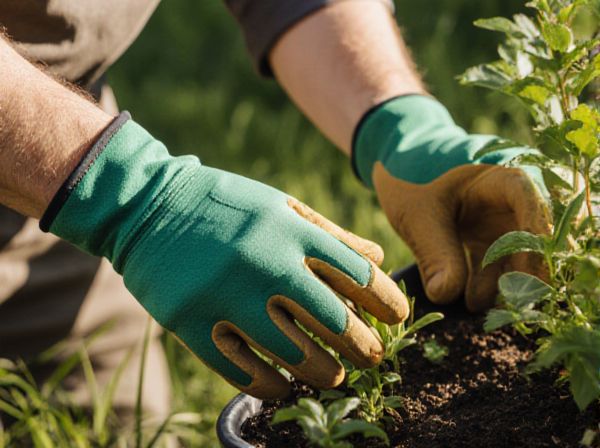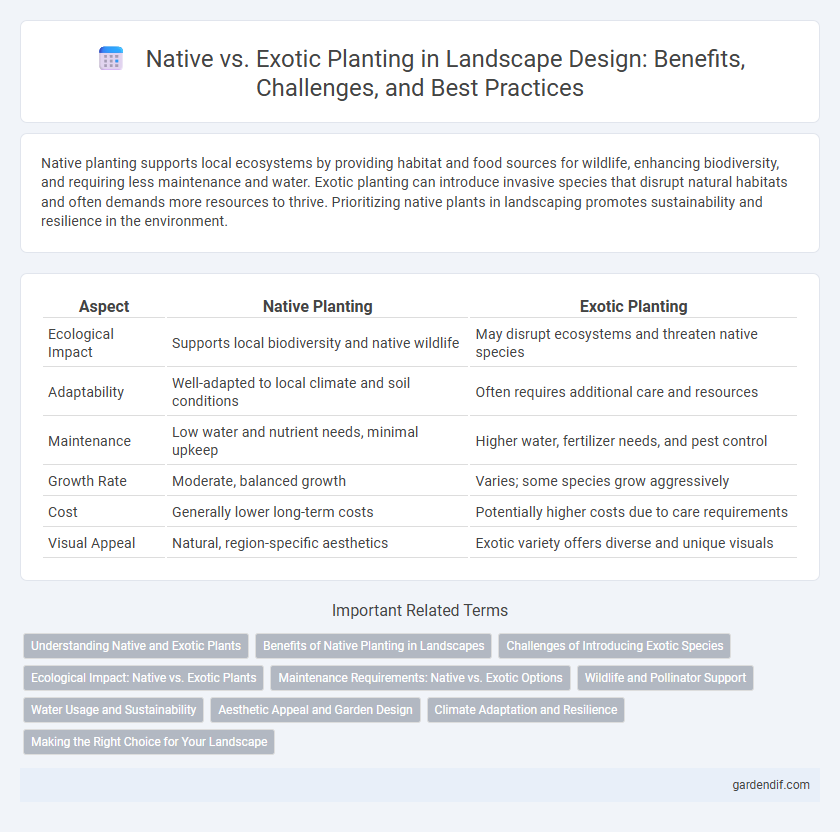
Native Planting vs Exotic Planting Illustration
Native planting supports local ecosystems by providing habitat and food sources for wildlife, enhancing biodiversity, and requiring less maintenance and water. Exotic planting can introduce invasive species that disrupt natural habitats and often demands more resources to thrive. Prioritizing native plants in landscaping promotes sustainability and resilience in the environment.
Table of Comparison
| Aspect | Native Planting | Exotic Planting |
|---|---|---|
| Ecological Impact | Supports local biodiversity and native wildlife | May disrupt ecosystems and threaten native species |
| Adaptability | Well-adapted to local climate and soil conditions | Often requires additional care and resources |
| Maintenance | Low water and nutrient needs, minimal upkeep | Higher water, fertilizer needs, and pest control |
| Growth Rate | Moderate, balanced growth | Varies; some species grow aggressively |
| Cost | Generally lower long-term costs | Potentially higher costs due to care requirements |
| Visual Appeal | Natural, region-specific aesthetics | Exotic variety offers diverse and unique visuals |
Understanding Native and Exotic Plants
Native plants are species that have evolved naturally in a specific region, adapting to local climate, soil, and wildlife, thus supporting ecosystem stability and biodiversity. Exotic plants, introduced from different geographical areas, may offer aesthetic appeal but can sometimes disrupt native habitats or become invasive. Understanding the ecological roles and growth requirements of native versus exotic plants is essential for sustainable landscape design and environmental conservation.
Benefits of Native Planting in Landscapes
Native planting in landscapes enhances biodiversity by supporting local wildlife, including pollinators and birds, which thrive on indigenous flora. These plants are naturally adapted to the region's soil, climate, and water conditions, reducing the need for irrigation, fertilizers, and pesticides, leading to sustainable landscape maintenance. Incorporating native species improves soil health, prevents erosion, and contributes to ecological balance, making landscapes more resilient and environmentally friendly.
Challenges of Introducing Exotic Species
Introducing exotic species in landscape design often leads to ecological imbalances, including the displacement of native flora and disruption of local wildlife habitats. Exotic plants may require higher maintenance due to unfamiliar soil and climate conditions, increasing water and pesticide usage. Invasive tendencies of some exotic species can cause long-term harm to biodiversity and complicate ecosystem management efforts.
Ecological Impact: Native vs. Exotic Plants
Native planting supports local biodiversity by providing essential habitat and food sources for indigenous wildlife, promoting ecosystem stability and resilience. Exotic planting often disrupts these ecosystems by outcompeting native species, leading to reduced biodiversity and altered soil and water dynamics. Prioritizing native plants enhances ecological balance and sustains long-term environmental health in landscape design.
Maintenance Requirements: Native vs. Exotic Options
Native planting significantly reduces maintenance requirements due to plants' adaptation to local soil, climate, and pests, minimizing the need for irrigation, fertilizers, and pesticides. Exotic planting often demands intensive care, including frequent watering, pest control, and soil amendments, as non-native species struggle to thrive in unfamiliar conditions. Choosing native species promotes sustainable landscaping with lower resource consumption and long-term ecological balance.
Wildlife and Pollinator Support
Native planting supports local wildlife and pollinators by providing essential habitats and food sources tailored to regional ecosystems. Exotic planting often lacks these co-evolved relationships, potentially reducing pollinator diversity and disrupting ecosystem balance. Prioritizing native plants enhances biodiversity and strengthens ecological resilience in landscape design.
Water Usage and Sustainability
Native planting significantly reduces water usage due to its adaptation to local climate and soil conditions, requiring less supplemental irrigation compared to exotic species. Using native plants promotes sustainability by preserving local biodiversity, supporting native pollinators, and maintaining natural ecosystem balance. Exotic planting often demands more water and maintenance, increasing resource consumption and potentially introducing invasive species that disrupt native habitats.
Aesthetic Appeal and Garden Design
Native planting enhances garden design by providing a harmonious aesthetic that reflects the local ecosystem, promoting biodiversity and seasonal interest with region-specific blooms and foliage textures. Exotic planting introduces striking contrasts through varied colors, shapes, and sizes of non-native species, allowing for bold, unique focal points and customized garden themes that stand out visually. Balancing native and exotic plants can create dynamic landscapes that maximize visual appeal and ecological resilience.
Climate Adaptation and Resilience
Native planting enhances landscape climate adaptation by supporting local ecosystems, improving soil stability, and requiring less water and maintenance due to plants' natural resilience to regional weather patterns. Exotic planting often struggles with climate resilience as non-native species may lack tolerance to local temperature fluctuations, pests, and soil conditions, increasing vulnerability to environmental stress. Prioritizing native species promotes sustainable, climate-resilient landscapes by fostering biodiversity and reducing the need for additional resources.
Making the Right Choice for Your Landscape
Choosing native plants supports local ecosystems by providing habitat and food for indigenous wildlife, enhancing biodiversity and requiring less water and maintenance due to their natural adaptation. Exotic plants may offer unique aesthetics and rare colors but often demand more resources and can risk becoming invasive, disrupting local habitats. Evaluating soil conditions, climate, and long-term sustainability helps determine whether native or exotic species align best with your landscape goals.
Native Planting vs Exotic Planting Infographic

 gardendif.com
gardendif.com